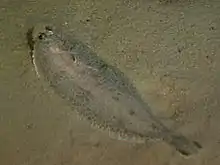Glyptocephalus
Glyptocephalus is a genus of righteye flounders found in the North Atlantic and North Pacific Oceans
| Glyptocephalus | |
|---|---|
 | |
| Glyptocephalus cynoglossus | |
| Scientific classification | |
| Kingdom: | Animalia |
| Phylum: | Chordata |
| Class: | Actinopterygii |
| Order: | Pleuronectiformes |
| Family: | Pleuronectidae |
| Subfamily: | Pleuronectinae |
| Genus: | Glyptocephalus Gottsche, 1835 |
| Type species | |
| Pleuronectes saxicola Faber, 1828 | |
Etymology
The word Glytocephalus is derived from the Greek γλύφειν (glyphein), meaning "to carve", and κεφαλή (kephalē), meaning "head".
Species
There are currently three recognized species in this genus:[1]
| Image | Scientific name | Common Name | Distribution |
|---|---|---|---|
 | Glyptocephalus cynoglossus (Linnaeus, 1758) | witch, witch flounder, pole flounder, craig fluke, Torbay sole and grey sole | North Atlantic Ocean |
 | Glyptocephalus stelleri (P. J. Schmidt, 1904) | Blackfin flounder | northern Pacific, from the Sea of Japan to the Strait of Tartary and southern Kuril Islands and out into the Bering Sea. |
 | Glyptocephalus zachirus Lockington, 1879 | Rex sole | northern Pacific, from Baja California in Mexico up the coasts of the United States, British Columbia and Alaska, across the Bering Sea to the coast of Russia and the Sea of Japan. |
References
- Froese, Rainer and Pauly, Daniel, eds. (2012). Species of Glyptocephalus in FishBase. October 2012 version.
This article is issued from Wikipedia. The text is licensed under Creative Commons - Attribution - Sharealike. Additional terms may apply for the media files.